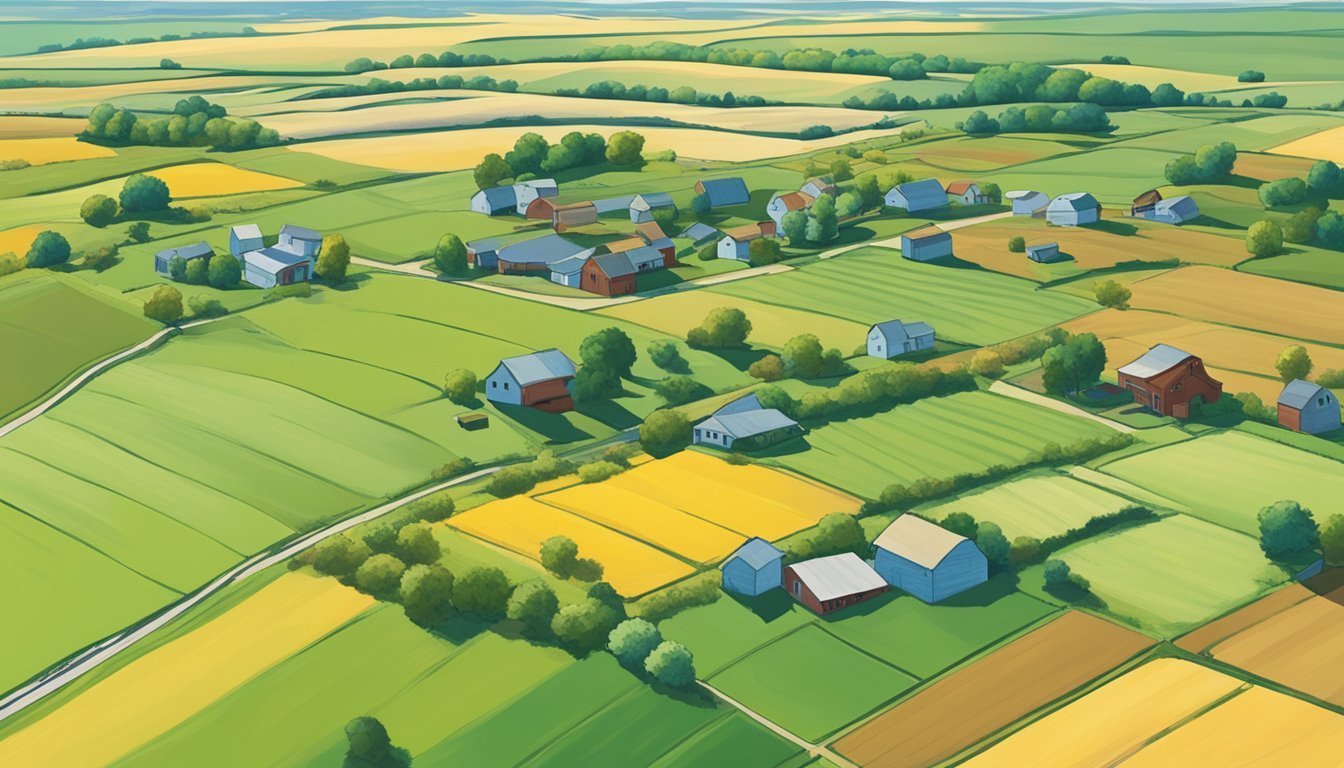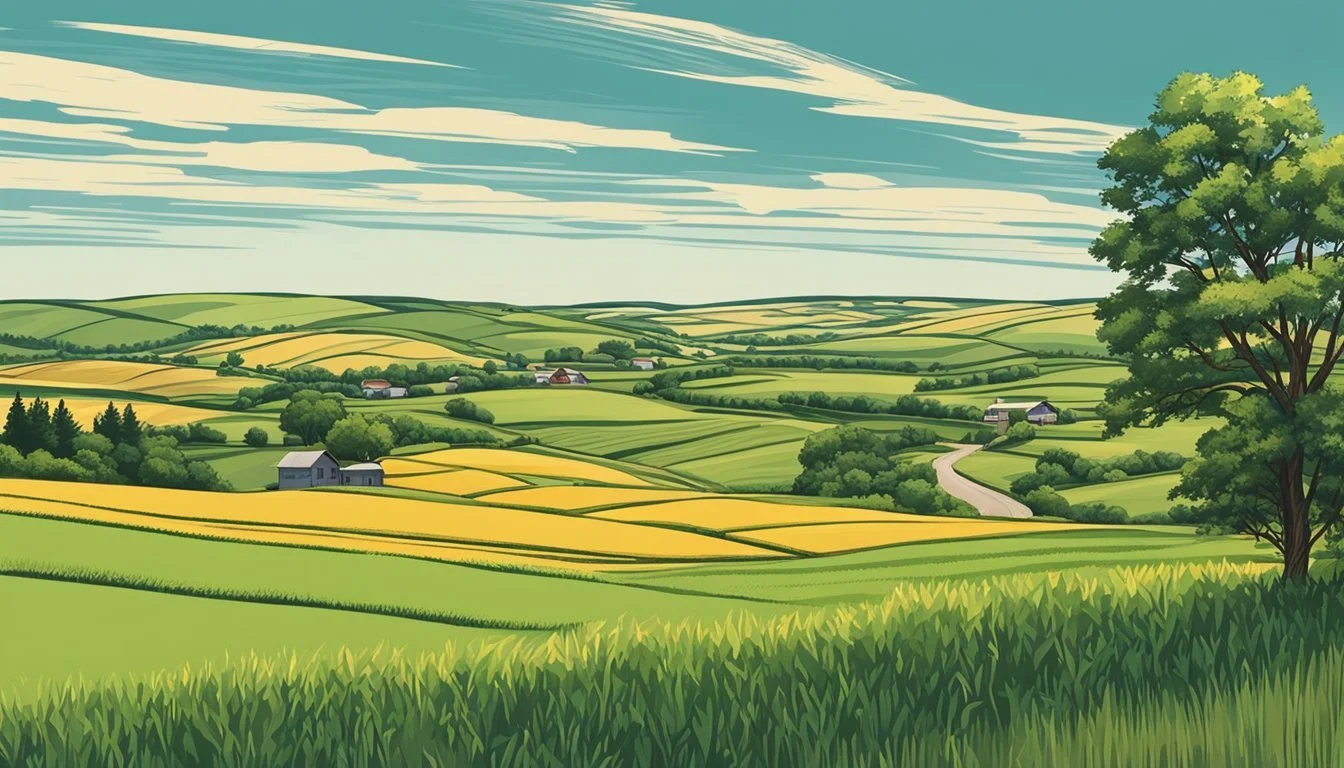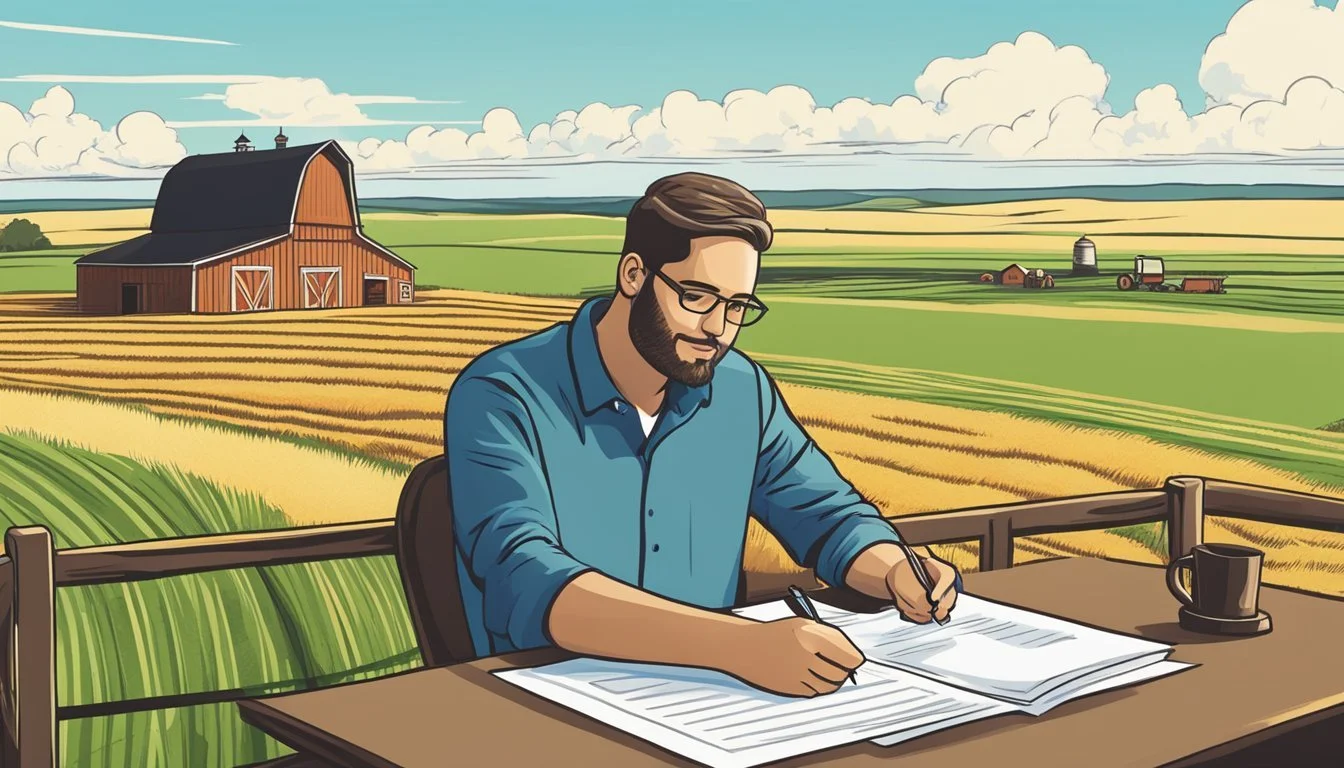Small Farms for Sale in North Dakota
Your Guide to Rural Opportunities
This Article is Part of State-by-State Guide to Buying Your First Small Farm
North Dakota, with its vast plains and prairie lands, has become an attractive location for those looking to purchase small farms. The state's agricultural industry is robust, offering potential buyers a variety of options when it comes to small-scale farming. Small farms for sale in North Dakota typically fall within a diverse price range and are scattered across different counties, catering to a range of farming interests and budgets.
The availability of small farms in North Dakota presents opportunities for both experienced and novice agricultural enthusiasts. These properties often come with the necessary infrastructure for a variety of agricultural pursuits ranging from crop farming to ranching. With an emphasis on community and the growing interest in sustainable farming, owning a small farm in North Dakota could provide a rewarding lifestyle and a valuable investment for the future.
Given the fluctuating nature of real estate and the nuances associated with agricultural land, it is important for prospective buyers to thoroughly research and consider all factors involved in purchasing farm property. While market listings show properties across locations like Gilby, New Rockford, and Leeds, the diverse geographic and climate conditions of North Dakota can greatly influence farming potential. Therefore, careful assessment of each property's capabilities and the buyer's own objectives is crucial in the decision-making process.
Benefits of Investing in Small Farms in North Dakota
Small farms in North Dakota offer unique advantages for investors seeking affordability and diverse agricultural prospects. The state presents a lower price point per acre compared to many other regions, which is coupled with a range of agricultural opportunities due to its varied climate and soil types.
Affordable Acreage
North Dakota is known for offering larger plots of land at more affordable prices, particularly when it comes to small farms. The real estate market here allows investors to acquire more acreage for their money, creating a value proposition that is hard to overlook.
Price per Acre: On average, the state offers competitive rates, which can be particularly attractive to those looking to enter the agricultural space without a significant initial capital outlay.
Agricultural Opportunities
Investing in North Dakota's small farms presents a variety of agricultural opportunities. The state's climate and fertile soil are conducive to a range of crops and livestock, making it an ideal location for both traditional and specialized farming operations.
Crops: Investors find that the land is suitable for several staple crops including wheat, soybean, and corn among others, providing a stable foundation for crop rotation and land management.
Livestock: Those interested in animal husbandry can also engage in raising livestock such as cattle, which is a well-established industry in the state.
Understanding the Real Estate Market
In North Dakota, the real estate market for small farms showcases a blend of attractive listing prices and varied acreage. Potential buyers can identify trends in market dynamics and pricing that can influence the investment value of land for a sale.
Current Market Trends
The small farm real estate in North Dakota is characterized by a stable inventory with properties ranging from under 20 acres to over 30 acres. Recent listings have been on the market for an average of a few months, indicating consistent buyer interest. The properties often feature additional amenities such as large residential structures and outbuildings, which add to their value.
Listing Duration: Properties typically stay on the market for 2 to 4 months.
Property Features: Listings include added amenities like houses and barns, which affect market value.
Price Comparisons
To provide a clear picture of the financial landscape, here is a comparison of recent listing prices:
Acreage Listing Price County Amenities 19.7 $199,900 Benson None Listed 19 $285,000 Logan 1,280 sq ft residence; 3 bd 31 $385,000 Mountrail 3,262 sq ft residence; 5 bd 6.87 $299,900 Logan 3,280 sq ft residence; 4 bd
Price Range: Listings show a range from under $200,000 to nearly $400,000.
Price Influencers: Factors such as size, location, and residential structures significantly impact the listing and potential purchase price.
In summary, buyers should consider the stable market trends and variable listing prices while making informed decisions on purchasing small farms in North Dakota.
Guide to Small Farm Acreage
When considering small farms for sale in North Dakota, the two critical factors potential buyers should assess are the property size and the kind of land on offer.
Determining Property Size
Property Size defines both the scale of the agricultural operations and the management responsibilities. Small farms in North Dakota can range from under 10 acres to several hundred acres. Buyers should match the size of the farm with their intended use, resources, and the type of farming they wish to engage in. Properties can range from 6.87 acres in Logan County suitable for boutique farming, up to larger, more expansive plots of over 30 acres in Mountrail County, which can support full-scale agricultural activities.
Types of Land Available
The Types of Land Available for small farms in North Dakota include:
Tillable Land: Typically flat or gently rolling fields that are ideal for crop production. This land is easily accessible and promotes efficient mechanization.
Pasture Land: This is grassland suitable for grazing livestock. It is often fenced and may include water sources like ponds or streams.
Mixed-Use Land: This category includes a combination of tillable fields and pasture or forested land, providing a diverse range of potential uses.
Buyers should analyze the land’s soil quality, water availability, and existing infrastructure to ensure it meets their specific farming needs.
Financial Considerations
When purchasing small farms in North Dakota, potential buyers must carefully evaluate the cost and explore available financing options to ensure a sound investment.
Evaluating the Cost
The purchase price of small farms in North Dakota varies depending on factors such as location, acreage, and existing facilities. Recent listings show that prices can be as low as $199,900 for a 19.7-acre property in Benson County to around $385,000 for a 31-acre farm in Mountrail County. Buyers should not only consider the initial asking price but should also account for additional costs such as property taxes, insurance, and maintenance expenses which can affect the overall affordability.
Financing Options
Prospective buyers have several financing options to consider when purchasing agricultural land:
Conventional Loans: Commercial banks and mortgage brokers offer these, with terms typically requiring a down payment.
Agricultural Loans: Specifically tailored for farming needs, these can provide more favorable terms such as lower interest rates and longer repayment periods.
USDA Programs: The United States Department of Agriculture offers various programs, including the Farm Service Agency (FSA) loans, which are designed to help farmers purchase land.
Investors should consult with financial advisors or lending professionals specializing in agricultural properties to identify the most advantageous financing path according to their specific circumstances and financial goals.
Regions for Farming in North Dakota
North Dakota offers diverse regions that are suitable for farming, each with its own characteristics. From the fertile soils of Stutsman County to the expansive acreages in Ward County, farmers can find landscapes that fit a variety of agricultural needs.
Adams County
In Adams County, small to medium-sized farms dominate the agricultural landscape. The region's soil and climate conditions are conducive to wheat and grain production. Farm acquisition here is tailored to those looking for manageable plots with potentials for crop diversification.
Bowman County
Bowman County's rolling hills and grasslands present ideal conditions for both livestock and crop farming. This county offers ample opportunities for ranching, with sufficient space for grazing combined with areas suitable for planting staple crops such as corn and soybeans.
Burleigh County
Located centrally, Burleigh County benefits from its proximity to Bismarck, the state capital, offering farmers easy access to markets and farm services. This county is known for a mix of farming and ranching, with an emphasis on soybeans, grains, and beef production.
Stutsman County
As one of the most agriculturally productive counties in North Dakota, Stutsman County boasts vast tracts of fertile land. This region is a top producer of corn, soybeans, and wheat, attracting farmers who are looking to harness the county's high-yield potentials.
Ward County
Ward County's agriculture is bolstered by its large areas of arable land and support infrastructure. It's a hub for both traditional farming and more innovative agricultural practices. This county is an attractive destination for farmers seeking to grow a variety of crops or raise livestock on a larger scale.
Legal and Zoning Considerations
When purchasing small farms in North Dakota, a prospective buyer must navigate a range of legal and zoning regulations that affect how the property can be used.
Zoning Laws and Regulations
North Dakota's zoning laws dictate the permissible uses for parcels of land, with agricultural zoning typically allowing a range of farming activities. Such regulations can impact the types of structures allowed, the number of animals permissible, and potential commercial activities. Before buying, one should review:
Local zoning ordinances: Specific requirements for agricultural property use and any restrictions tied to the size and type of buildings permitted.
Future land use plans: Documentation that could indicate planned changes affecting the area, ensuring the longevity of the property’s intended agricultural use.
Property Rights
Property rights are associated with owning land in North Dakota and they define the extent of control a property owner has over their land, which includes:
Surface rights: Entail the legal ownership and use of the surface area of the land for farming practices.
Mineral rights: Separate from surface rights and can be sold or leased independently, thus affecting potential income or land usage.
Buyers must ensure that a thorough title search is conducted to ascertain any easements, covenants, or other legal encumbrances that could affect their use of the property. They should consult with a real estate attorney experienced in North Dakota property law to navigate these complexities.
Steps to Purchase
Purchasing a small farm in North Dakota involves a series of steps, from discovering available properties to finalizing the sale. Careful consideration of listings and understanding the financial commitments are essential for a successful transaction.
Finding Listings
Prospective buyers can start by exploring properties through various online real estate platforms that list small farms for sale in North Dakota. Prices for small farms may range significantly based on location, acreage, and included amenities. It is important for buyers to routinely check these platforms, as listings are updated regularly with options such as a 19-acre farm in Logan County or a 31-acre property in Mountrail County.
Making an Offer
Once a suitable farm is identified, the buyer should conduct a thorough analysis of the listing price and any associated costs, and then proceed to make an offer. This offer should be in writing and include contingencies such as financing and inspection. For transparency, the buyer can outline the terms and conditions associated with the offer.
Closing the Sale
After the offer is accepted, the closing process begins. This includes finalizing the financial arrangements, which commonly involves securing a loan unless the purchase is a cash transaction. The buyer should be prepared for closing costs and ensure all the necessary paperwork is completed to transfer the ownership of the farm. Closing the sale finalizes the purchase and allows the buyer to take possession of their new property in North Dakota.
Starting a Farm Business
When considering the purchase of real estate for starting a farm in North Dakota, potential buyers should focus on business planning and sustainable farming practices, which are crucial for the long-term success of their agricultural ventures.
Business Planning
A solid business plan is essential for anyone looking to invest in farms for sale in North Dakota. This plan should detail the acreage required, types of crops or livestock, and the financial projections. It must include:
Market Analysis: To understand the demand for agricultural products in the area.
Financial Plan: Outlining the initial investment, ongoing costs, and expected revenue.
Operations Plan: Describing the day-to-day activities necessary to run the farm.
Key Component Description Executive Summary Brief overview of the business goals and vision. Company Description Details about the farm, size, and type of agricultural activities. Organization & Management Structure of the farm's management team and personnel needs.
Sustainable Farming Practices
Sustainable farming practices are increasingly important in the agricultural industry. A buyer should look for acreage that enables:
Crop Rotation: To maintain soil health and reduce pests and diseases.
Conservation Tillage: Reducing soil erosion and improving water retention.
Integrated Pest Management (IPM): Employing strategies to minimize pest damage with the least possible impact on the environment.
Strategies for sustainability should also be incorporated into the farm business plan, with a focus on:
Energy Efficiency: Utilizing renewable energy sources and energy-saving technologies.
Water Management: Implementing systems for efficient water use and conservation.
By adhering to these principals, one can ensure the farm not only contributes to the food supply but does so responsibly and sustainably.




